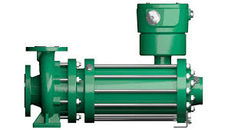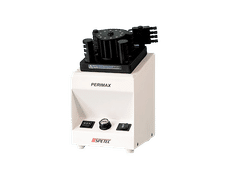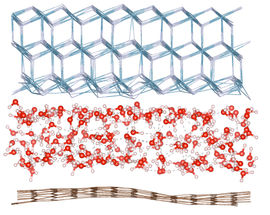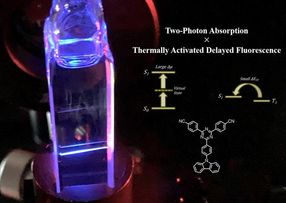Light-Emitting Diodes for Night-Vision Displays
Redder than Red: Porphyrin complex used as doping agent in highly efficient infrared-light-emitting diodes
More and more, conventional inorganic semiconductor electronics are being complemented with organic components. For example, flexible displays, large illuminated displays, or flat-panel displays can be made from organic light-emitting diodes (OLEDs). Whereas research into OLEDs has thus far focused almost exclusively on those that emit light in the visible part of the spectrum, American researchers led by Mark E. Thompson have worked on OLEDs that emit infrared light. Such diodes are needed for displays meant to be viewed through night-vision devices. The research team from the University of Southern California, Princeton University, and the University of Michigan, as well as the Universal Display Corporation divulged the secret behind their success: a phosphorescent platinum porphyrin complex used as a doping agent.
An OLED is a thin, glowing component made of organic, semiconducting materials whose structure resembles that of an inorganic light-emitting diode (LED). Between two electrodes, as well as additional layers, is a dye-containing emission layer. When a voltage is applied, the cathode pumps electrons into the emission layer while the anode pumps in electron "holes". This puts the dye into an excited state. When the dye molecules return to their ground state, energy is released in the form of light. Previously, the emission layers in OLEDs were doped with fluorescent dyes. Phosphorescent dopants are expected to result in significantly more efficient OLEDs. Phosphorescent dyes emit light for a longer period of time, because they are "trapped" in their excited state and cannot return to their ground state as easily.
The color of the light emitted depends on the difference in energy between the two energy levels. This in turn depends on the precise structure of the dye molecule. Thompson and his team chose to use a platinum porphyrin complex as their phosphorescent doping agent. Porphyrins can be found in such substances as hemoglobin and chlorophyll. The framework of a porphyrin complex consists of four nitrogen-containing five-membered rings that are connected into one large cyclic structure. The metal atom - in this case a platinum atom - sits in the center of this ring. The researchers tweaked the other details of the molecular structure so that their saddle-shaped porphyrin emits light in the infrared region of the spectrum; and very efficiently too, when it is included in the emission layer of an OLED.
Original publication: Mark E. Thompson et al.; "Highly Efficient, Near-Infrared Electrophosphorescence from a Pt-Metalloporphyrin Complex"; Angewandte Chemie International Edition 2007, 46, No. 7, 1109-1112.
Most read news
Organizations
Other news from the department science
These products might interest you

Typ CNF / Typ CAM by Hermetic-Pumpen
Reliable pump technology for hazardous applications
Shaft seal-free pumps for maximum reliability and safety

Peristaltic Pumps by AHF analysentechnik
Reliable and Low-pulsation Transport of Liquids in Laboratory Analysis

AZURA Analytical HPLC by KNAUER
Maximize your analytical efficiency with customized HPLC system solutions
Let your application define your analytical system solution

Get the chemical industry in your inbox
By submitting this form you agree that LUMITOS AG will send you the newsletter(s) selected above by email. Your data will not be passed on to third parties. Your data will be stored and processed in accordance with our data protection regulations. LUMITOS may contact you by email for the purpose of advertising or market and opinion surveys. You can revoke your consent at any time without giving reasons to LUMITOS AG, Ernst-Augustin-Str. 2, 12489 Berlin, Germany or by e-mail at revoke@lumitos.com with effect for the future. In addition, each email contains a link to unsubscribe from the corresponding newsletter.



























































